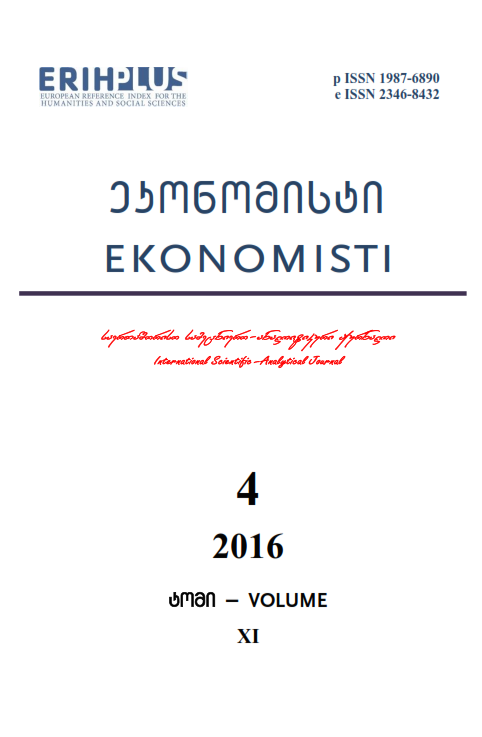
The international scientific and analytical, reviewed, printing and electronic journal of Paata Gugushvili Institute of Economics of Ivane Javakhishvili Tbilisi State University

The potential of the National Bank of Georgia in the direction of sustainable financing and the possibilities of digital transformation at the modern stage.
Expanded Summary
The National Bank of Georgia (NBG) is positioning itself at the intersection of sustainable finance and digital innovation, recognizing the potential synergies that can drive both economic growth and environmental stewardship. Through its comprehensive Sustainable Finance Roadmap, the development of a Sustainable Finance Taxonomy, the issuance of green bonds, and the exploration of Central Bank Digital Currencies (CBDC), the NBG is laying the groundwork for a future where finance contributes positively to sustainable development goals.
The regulatory laboratory (reglab) and open banking initiatives further exemplify the NBG's commitment to fostering a dynamic and inclusive financial ecosystem. The reglab not only supports the incubation of green financial products but also ensures that these innovations meet stringent regulatory standards. Open banking, on the other hand, democratizes financial services, empowering consumers and encouraging the creation of personalized, sustainable financial solutions.
The Digital GEL initiative for green finance represents a significant leap forward, harnessing the power of blockchain to ensure transparency and accountability in the allocation of funds for sustainable projects. This digital currency could revolutionize the way green finance is conducted, providing a secure and efficient means of funding environmental initiatives while preventing greenwashing and enhancing investor confidence.
As the NBG continues to integrate advanced technologies like AI and blockchain, it stands to significantly enhance the transparency, efficiency, and impact of its sustainable finance initiatives. The potential of AI in analyzing large datasets to identify sustainable investment opportunities and assess environmental impacts cannot be overstated. Similarly, blockchain technology offers unprecedented transparency and security, which are crucial for maintaining trust in green finance products.
Looking ahead, the NBG's efforts could serve as a model for other central banks worldwide. By leveraging digital transformation to support sustainable finance, the NBG not only addresses local economic and environmental challenges but also contributes to global efforts to combat climate change and promote sustainable development. Future collaborations with international partners and other central banks will be essential in establishing global standards and frameworks for green digital currencies, facilitating cross-border sustainable finance initiatives.
In conclusion, the National Bank of Georgia is at the forefront of an exciting and crucial evolution in the financial sector. By championing sustainable finance and embracing digital transformation, the NBG is paving the way for a resilient and inclusive financial system that supports both economic growth and environmental sustainability. The initiatives discussed in this article highlight the potential for significant positive impact, offering a roadmap for other institutions looking to integrate sustainability and digital innovation into their operations. The journey is ongoing, but the NBG's proactive approach and strategic initiatives provide a strong foundation for a sustainable financial future.
References
- Accenture. (2023). The Future of Open Banking and Sustainable Finance. https://www.accenture.com/us-en/insights/ banking/open-banking-sustainable-finance
- BIS. (2021). Digital Innovation in the Financial Sector. https://www.bis.org/publ/bppdf/bispap117.htm
- BIS. (2023). Green CBDCs: Opportunities and Challenges. https://www.bis.org/publ/bppdf/bispap119.htm
- IMF. (2022). Central Bank Digital Currencies and Financial Inclusion. https://www.imf.org/en/ Publications/fintech-notes/Issues/2022/02/01/Central-Bank-Digital-Currencies-and-Financial-Inclusion-50142
- KPMG. (2021). ბლოკჩეინი მწვანე ფინანსებისთვის. https://home.kpmg/xx/en/home/insights/2021/03/blockchain-for-green-finance.html
- NBG. (2021). მდგრადი დაფინანსების ტაქსონომია. https://www.nbg.gov.ge/index.php?m=728&lng=eng
- NBG. (2022). მდგრადი დაფინანსების გზამკვლევი. https://www.nbg.gov.ge/index.php?m=730&lng=eng
- NBG. (2023). მწვანე ობლიგაციების გამოშვების წლიური ანგარიში. https://www.nbg.gov.ge/index.php?m=711&lng=eng
- NBG. (2023). რეგულირების ლაბორატორიის წლიური ანგარიში. https://www.nbg.gov.ge/index.php?m=727&lng=eng
- NBG. (2024). ციფრული ლარი მწვანე ფინანსებისთვის „კონცეფციური ჩარჩო“. https://www.nbg.gov.ge/index.php?m=723&lng=eng
- Nguyen, T. (2019). The Role of Central Banks in Promoting Sustainable Finance. https://www.imf.org /en/Publications/WP/ Issues/2019/10/21/The-Role-of-Central-Banks-in-Promoting-Sustainable-Finance-48660
- PwC. (2023). Artificial Intelligence in Sustainable Finance. https://www.pwc.com/gx/en/services/sustainability/ai-in-sustainable-finance.html
- WEF. (2022). Digital Transformation and Sustainable Finance. https://www.weforum.org/agenda/2022/01/digital-transformation-sustainable-finance/
- World Bank. (2020). Sustainable Finance: An Overview. https://www.worldbank.org/en/ topic/ financialsector/brief/sustainable-finance
